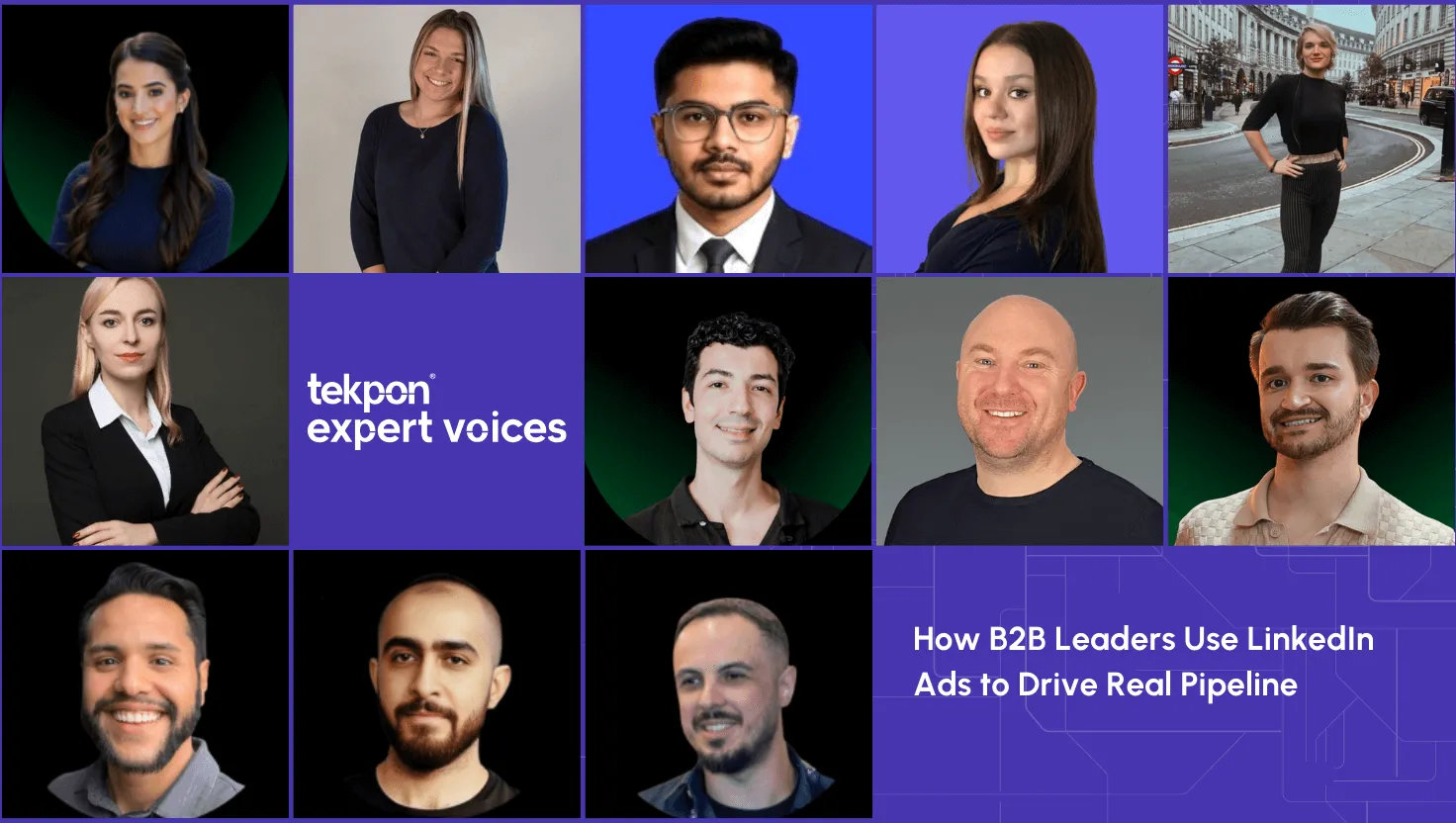How B2B Leaders Use LinkedIn Ads to Drive Real Pipeline

Table of Contents
- Shift from Lead Gen to Account-Based Awareness
- Warm Audiences First, Then Convert
- Reach the 95% Not Ready to Buy
- Treat LinkedIn Like Dating, Not a Vending Machine
- LinkedIn as a Stage Production, Not Roulette
- Alignment Between Marketing and Sales
- Optimize for Conversations, Not Clicks
- Test, Evaluate, and Scale
- Precision Targeting with Enriched Data
- Think Like a Buying Committee
- Thought Leadership Over Promotions
- Integrate Ads with Outbound Motions
- Showcase Value, Not Just Features
- Conclusion: Pipeline Isn’t About Ads, It’s About Strategy
If you’ve ever run LinkedIn Ads for B2B, you know the frustration: plenty of clicks, a flood of leads, but when you ask sales, “Where’s the pipeline?” crickets. The problem isn’t the platform. It’s the mindset.
Too many companies treat LinkedIn like a lead vending machine: dump in budget, crank out MQLs, and hope something sticks. But the B2B leaders who actually move the needle? They don’t chase leads. They build awareness, trust, and relationships, long before a demo is ever booked.
We talked to 13 industry experts, VP-level marketers, revenue leaders, and growth strategists, who’ve cracked the code on turning LinkedIn Ads into a predictable pipeline engine.
Shift from Lead Gen to Account-Based Awareness
Emilia Korczynska emphasizes that the key is to focus on accounts, not individual leads. Herapproach highlights the importance of account-based marketing (ABM).
LinkedIn ads can absolutely drive pipeline but most B2B companies don’t see ever see it [the pipeline] as they apply the same contact-based mindset and attribution as the used to do for lead gen. In B2B, it’s the accounts that make buying decisions, not individual leads.
The goal is to drive awareness of your product in the target audience by serving different personas ads from different funnel stages, deanonymize their engagements and see the pipeline opened from the “aware” accounts (we use zenabm.com for both), and then meaningfully engage those that don’t convert directly with email and LinkedIn (with Smartlead/ Heyreach).
Not to generate leads through lead magnet downloads and then dog those leads to book a demo, or drive direct last-touch conversions.
By targeting entire accounts and using tools to deanonymize engagement, companies can identify high-intent buyers and nurture them effectively. The focus shifts from chasing leads to building awareness and trust within key accounts.
Warm Audiences First, Then Convert
LinkedIn Ads aren’t just for top-of-funnel (TOFU) activities. Chris Chambers explains how a multi-stage funnel approach can turn cold audiences into warm leads and, ultimately, pipeline.

Many mistake LinkedIn Ads for only top of funnel action. This isn’t the case.
The best strategies are typically to warm your audience with TOFU ad types like Thought Leader Ads and image ads, then lead them into a funnel with document ads and more direct action image/video ads that contain a strong CTA.
Once you have your first audiences warmed and your audience list targeting honed in, you begin the remarketing and this is where direct leads really start to come in.
This also allows you to build lists to integrate with the rest of your GTM motions such as outbound email, LinkedIn outbound, and paid search.
His strategy underscores the importance of sequential messaging. By first educating and engaging audiences with thought leadership, then guiding them toward conversion-focused content, companies can create a seamless journey that drives real results.
Reach the 95% Not Ready to Buy
Most B2B buyers aren’t actively in the market at any given time. Adam Holmgren stresses the importance of building awareness at scale to capture future demand.

LinkedIn Ads is the single best channel to reach B2B decision makers, period.
But here’s where most companies get it wrong: they chase leads instead of building awareness at scale.
Remember the 95:5 rule. Only 5% of your market is actively buying right now. The real job of LinkedIn Ads is to reach the other 95% and engage them with your narrative so you’re the obvious choice when they’re ready.
By staying present with potential buyers, you maximize the chance of turning today’s impressions into tomorrow’s pipeline.
My go-to formats are Thought Leader Ads and Conversation Ads. They bring personal authenticity into paid campaigns in a way that cuts through, and they’re still massively underused.
But don’t stop there. Layer in image or video ads with distinctive brand assets (mascot, colors, logos) so your brand sticks in buyers’ minds over time.
He advocates for Thought Leader Ads and Conversation Ads, which bring authenticity to paid campaigns. By staying top-of-mind with potential buyers, companies maximize their chances of converting future opportunities.
Treat LinkedIn Like Dating, Not a Vending Machine
JD Garcia compares LinkedIn Ads to dating, skipping the small talk leads to poor conversion rates. A structured funnel approach is essential for success.

Most B2B brands run LinkedIn Ads like they’re trying to win a one-night stand.
Cold audience. Straight to ‘Book a demo.’ Shocked when conversion rates are trash.
The truth? LinkedIn is not a vending machine for MQLs. It’s more like dating — and if you skip the small talk, you’re going home alone.
The companies actually driving pipeline get this:
Top-of-funnel = thought leadership, stories, bold POVs. This is where you build trust.
Mid-funnel = problem-aware content. Think case studies, breakdowns, insights that make someone nod and go, ‘Yep, that’s me.’
Bottom-of-funnel = now you’ve earned the right to ask for the call. That’s when the ‘Book a Demo’ button actually works.
Bonus: when everyone else ghosts Q4 and cuts spend, your CPMs drop and you can hoard retargeting data like a dragon sitting on gold. That means your Q1 pipeline starts weeks ahead of your competition.
Stop treating LinkedIn like a slot machine where you just pull the lever and pray. Respect the funnel, keep showing up, and your ads stop being an expense — they become the reason you actually hit your goals.
By respecting the funnel and maintaining consistent engagement, companies can turn LinkedIn Ads into a predictable pipeline driver.
LinkedIn as a Stage Production, Not Roulette
Matt Hayman argues that precision and timing are critical to LinkedIn Ads success.

The wrong game on LinkedIn Ads is roulette: scatter budgets across broad audiences, celebrate the chip that lands, and call it “pipeline.”
But roulette rewards luck, not control and Sales feels the difference.
Because LinkedIn is incredible distribution with very opinionated defaults. Those defaults (always-on delivery, broad retargeting, generic objectives) make activity easy and impact hard. Leaders who drive real pipeline treat LinkedIn like a stage production: the right scene, for the right character, at the right moment.
Therefore, three rules:
Progress over volume. Define pipeline as stage movement, not MQL accumulation. Every campaign must have a “next best action” and an exclusion for people who took it.
Timing is a variable. Performance swings by day and hour. Treat schedule like creative: test it, constrain it, and concentrate spend where your buyers actually engage.
Memory is the asset. Most ads chase attention; winning ads build recall. Keep a consistent story spine across formats, then escalate proof as intent increases.
Do this and your reporting changes. CTR and CPL become evidence, not goals. Your dashboard starts answering executive questions: Which audiences progressed? Which scenes moved meetings? Where should we double-down?
Treating campaigns like a stage production, with the right scene, character, and moment, ensures impact.
Alignment Between Marketing and Sales
Daria Kalinina highlights the importance of alignment between marketing and sales to convert LinkedIn Ad engagement into pipeline.

Make sure your marketing and sales operate as one revenue team. Too many strong campaigns stall between initial engagement and a timely, informed follow-up. If your sales team is not seeing the same signals your marketing team is, you are paying for attention you cannot convert.
Stop relying on last-click attribution. In a dark funnel, multi-touch journey, engagement signals are your leading indicators. Do not leave that data sitting in a marketing dashboard. Share it with sales in real time, align on which accounts are truly relevant, decide where to lean in with a tailored message, and identify where to slow down. That cadence is what turns ad spend into qualified pipeline.
And do not show up as “just another ad.” Put real voices in market: your executives and practitioners being clear and opinionated about the problems you solve. Anchor the story in outcomes your product delivers, keep the narrative consistent across the buying committee, and meet stakeholders across multiple touchpoints. Familiarity compounds into trust, and trust shortens sales cycles.
If LinkedIn Ads performance has plateaued, do not start with bids and budgets. Start with alignment, instrumentation, and message. A twenty-minute weekly revenue sync and a shared engagement report will do more for your pipeline than another round of creative tweaks.
By breaking down silos and fostering collaboration, companies can turn ad spend into qualified pipeline.
Optimize for Conversations, Not Clicks
Tiberiu Oprea emphasizes that real pipeline comes from meaningful conversations, not vanity metrics.

When it comes to LinkedIn Ads for B2B, most leaders fall into the same trap: they optimize for clicks and impressions instead of real conversations that move deals forward. In my experience, pipeline is built when marketing stops chasing vanity metrics and starts creating clarity for the buyer.
That means three things
First, know your numbers. A clean pipeline doesn’t come from campaigns that “look good” in reports. It comes from understanding the full equation—impressions, clicks, conversion rate, cost per lead, but also what happens after the form is filled. If you don’t connect ad performance with sales outcomes, you’re not running demand generation—you’re buying noise.
Second, test relentlessly. The perfect campaign doesn’t exist. What separates high-performing SaaS companies on LinkedIn is not a secret tactic, but the speed with which they test and correct. Run structured experiments with creative, targeting, and offers, then double down on what proves to generate qualified conversations, not just leads.
Third, put people before product. LinkedIn is still one of the few places where decision-makers listen if you talk like a human. Founders and executives should use ads to amplify their own voice—sharing perspective, insights, even hard lessons learned. Buyers don’t connect with corporate jargon; they connect with clarity, honesty, and authority.
If you treat LinkedIn Ads as a lever for short-term lead counts, you’ll likely be disappointed. But if you use it as a disciplined system to build trust, measure what really matters, and consistently show up with value, it becomes one of the strongest engines for real pipeline.
Know your numbers. Test relentlessly. Use authentic voices to build trust.
Test, Evaluate, and Scale
Kenna Rooney shares how data-driven testing can optimize LinkedIn Ads for pipeline generation.

LinkedIn Ads has proven to be another activation channel to meet our buyers where they are, with reporting options like audience penetration helping us validate that it effectively reaches our ICP.
The platform allows us to test everything from custom audience segmentation and ad formats to CTA options and user experience, then evaluate metrics like CPL, conversion rate, CTR and so much more to see the bigger picture of which campaign formats resonate best before scaling those successful approaches.
Because of this, it has become crucial in contributing to our overall demand gen strategy and pipeline generation. If you’re in B2B and targeting professionals who you know spend time on LinkedIn, don’t sleep on reaching your audience where they’re already scrolling.
But be careful, LinkedIn has a few hidden tricks up their sleeve that can cost marketers in the blink of an eye.
This approach highlights the importance of continuous optimization and scaling what works to drive real results.
Precision Targeting with Enriched Data
Ali Yildirim explains how data orchestration can turn LinkedIn Ads into a precision instrument.

The best LinkedIn advertisers are building custom account lists OUTSIDE of the platform and uploading them to create the most targeted ad campaigns. This is made possible by revolutionary tools like Clay that consolidate 100s of possible enrichments and data sources.
What separates average from exceptional LinkedIn performance isn’t just the ads themselves. It’s the data orchestration happening behind the scenes. We’re seeing advertisers achieve 80 to 90 percent match rates by waterfalling enrichments across multiple providers, finding personal emails, work emails, phone numbers, and social profiles that LinkedIn’s native targeting simply can’t reach.
The real power comes from combining this enriched data with intent signals. When you can identify who’s engaging with competitor content, visiting specific websites, or discussing relevant topics on social platforms, then cross reference that with your uploaded lists, you’re not just running ads anymore. You’re orchestrating a sophisticated revenue engine where every impression counts and every click has context.
This approach transforms LinkedIn from a spray and pray channel into a precision instrument. The advertisers winning today aren’t the ones with the biggest budgets. They’re the ones with the smartest data strategies and the technical capability to execute them at scale.
By leveraging smart data strategies, companies can maximize the impact of every impression and click.
Think Like a Buying Committee
Robyn Repinski stresses the importance of targeting the entire buying committee, not just the decision-maker.

Here’s what I keep telling marketing teams: stop pretending you’re selling to ‘the decisionmaker’.
That CxO/VP you’re targeting isn’t making their purchase decisions in a vacuum. They’re influenced by the end user of your product alongside procurement, finance, IT, legal, and about six other people who will never ‘book a demo’ or attend your webinar. Nor will they all see your fantastic content with the right message for the right person at the right time.
I see this disconnect constantly. Marketing celebrates 100 leads while sales reports zero qualified opportunities in the pipeline. Why?
Because we’re optimising for the wrong KPI. The real decision influencers are researching your and your competitors’ solutions but staying invisible to the traditional lead generation process.
The procurement manager worried about vendor risk, the finance director questioning ROI and this year’s budget, the IT security lead concerned about compliance and the leadership is focusing on their new strategy on how to look good to board/investors.
The breakthrough happens when you start thinking like a buying committee, not a sales funnel for a decision maker. Use LinkedIn’s targeting to put the content that resonates with each stakeholders in the buying group. Share risk mitigation content with procurement, Payback period calculators with finance teams, security frameworks with IT. It’s relationship building at scale, but it requires patience & personalisation at scale with strategic use of human supervised generative AI.
What really opened my eyes was implementing tracking through LinkedIn’s Conversions API directly with my clients CRM systems. After connecting the API, we could finally see the truth: it wasn’t the campaigns with the highest clicks and leads driving pipeline (EU’s new regulations killed this form of tracking).
It was the funnels consistently reaching the entire buying group with the right message at the right frequency. The deals were closing because we’d touched procurement, finance, IT, and the decision-maker multiple times with relevant content until our brand became the trusted choice. The data tells stories our assumptions completely miss.
The question isn’t whether your ‘decision maker’ gives you their email. It’s whether the 10+ other people who influence their decision trust you enough to recommend you over your competitors when it matters.
Addressing the needs of the entire committee, companies can build trust and shorten sales cycles.
Thought Leadership Over Promotions
Junaid Dar’s data shows that thought leadership content outperforms promotions on LinkedIn.

1. Focus on Thought Leadership, Not Promotions
From our analysis of more than 120+ LinkedIn campaigns run from Jan 2023 onwards, the campaigns that consistently perform best are those that highlight thought leadership rather than product promotions. Decision-makers are 3-4X more likely to engage with insights, frameworks, and problem-solving ideas than with direct sales pitches.
When brands use LinkedIn to share knowledge and spark meaningful conversations, they build trust and credibility. That trust makes it easier for people to continue the relationship naturally.
Our Philosophy: The most effective LinkedIn campaigns help people by sharing expertise, not by selling to them.
2. Make It Easy for People to Engage
One of the biggest challenges in LinkedIn advertising is the drop-off that occurs when people are asked to leave the platform too quickly. Industry benchmarks show that landing pages convert at just 2 to 6 percent, while LinkedIn lead forms convert at nearly 13 percent, almost 2-3X better.
Our campaigns reflect this same trend. Redirecting audiences off-platform often leads to 60-80% of engagement being lost. Instead, we focus on offering value right inside LinkedIn. That could be a short guide, a simple template, or a resource people can access instantly. By keeping the experience simple and valuable, we build stronger relationships and reduce wasted ad spend.
Our Philosophy: We earn attention by making it easy for people to get value, not by asking them to jump through hoops.
3. Measure Success by Conversations, Not Clicks
Clicks and impressions don’t build pipelines, conversations do. Our philosophy is to start by boosting posts that build authority, capture engaged audiences with value-driven lead magnets, and then nurture those leads through a structured funnel.
Across our campaigns, this approach has led to 2–3x more qualified meetings booked compared to ad strategies focused on impressions alone. The real success of LinkedIn Ads comes when they drive conversations, sales calls, and pipeline growth, not just vanity metrics.
Our Philosophy: The real goal of LinkedIn Ads is to start conversations that matter, not to chase vanity numbers.
By focusing on value-driven content, companies can build stronger relationships and drive pipeline.
Integrate Ads with Outbound Motions
Ana Marturet emphasizes the need to connect LinkedIn Ads with outbound efforts for maximum impact.

LinkedIn Ads can’t live in a silo. They need to be tightly integrated with your outbound motion. If no one is following up on leads, adding them to nurturing programs, or reinforcing the message through email, the ads alone won’t drive impact.
The most effective strategies connect the dots: email nurtures that acknowledge the ad someone converted on, messaging that speaks directly to a pain point surfaced in your campaigns, or sequences that mirror the creative they engaged with.
The reverse is also true. If certain subject lines, messages, or offers are resonating in email, that’s gold you can feed back into LinkedIn. Use it to inform your conversation ads, creative direction, and even video or image assets. The synergy between outbound and paid social is what transforms isolated tactics into a cohesive growth engine.
It is also important to have an attribution tool that helps you understand the impact of brand awareness campaigns. Thought leadership ads, for example, are now performing very well, but without the right attribution in place it is easy to overlook their value. Many companies stop believing in LinkedIn advertising because they do not see direct ROI.
That can mean different things: they might not have a way to track it, they might not be following up efficiently with leads, the targeting may be off, or the audiences might not be in market to convert. In some cases the channel is simply not a fit for their business. However, in most cases I’ve seen, the issue comes down to one of these reasons rather than the platform itself.
By creating a unified growth engine, companies can turn LinkedIn Ads into a pipeline powerhouse.
Showcase Value, Not Just Features
Shubham Naliyapara shares how customer success stories can drive pipeline by addressing real challenges.

LinkedIn Ads have been one of the most effective ways I’ve driven a real B2B pipeline. Targeting the right decision-makers with content that addresses their challenges turns campaigns into meaningful opportunities rather than just lead generation.
One campaign that stood out was promoting a customer success story to mid-market tech leaders. Instead of a generic sales pitch, the content showcased real outcomes and solutions to their pain points. This approach not only increased engagement but also brought in warmer, more qualified leads, significantly reducing my cost per lead.
Retargeting played a crucial role as well. Running a sequence of ads from educational insights to case studies and demo invitations helped build trust and positioned me as a reliable IT services professional.
What really set me apart was my USP: I am currently working at Tibicle and have been able to consistently help clients reduce development costs by up to 40% while delivering high-quality, scalable solutions.
Combined with my LinkedIn Ads outreach and targeted campaigns, this strategy has allowed me to acquire a large number of new clients and expand my impact in the IT services space. The key lesson: LinkedIn Ads drive real pipeline when used strategically to showcase value, solve client problems, and guide prospects through their journey, not just to generate leads.
His key lesson: LinkedIn Ads drive real pipeline when used to showcase value and guide prospects through their journey.
Conclusion: Pipeline Isn’t About Ads, It’s About Strategy
If there’s one thing every expert here agrees on, it’s this: LinkedIn Ads don’t drive pipeline. Strategic LinkedIn Ads drive pipeline.That means:
No more spraying and praying. Broad audiences and generic CTAs won’t cut it. The winners are the ones who treat LinkedIn like a stage, carefully crafting the right message, for the right person, at the right time.
No more silos. Your ads can’t live in a vacuum. The moment someone engages, sales needs to know. The moment a lead stalls, marketing needs to retarget. The best teams operate as one revenue engine, not two separate functions.
No more vanity metrics. Clicks and impressions don’t pay the bills. What matters is conversations, meetings, and closed deals. If your dashboard isn’t showing you how ads influence those outcomes, you’re flying blind.
The companies that thrive on LinkedIn aren’t the ones with the biggest budgets. They’re the ones who understand the buyer’s journey, respect the funnel, and show up with value—not just another sales pitch.
So here’s your challenge: Pick one insight from the experts above and test it. Maybe it’s shifting from lead gen to account-based awareness. Maybe it’s warming audiences with thought leadership before hitting them with a CTA. Maybe it’s finally aligning your marketing and sales teams around the same engagement data.
Because the difference between LinkedIn Ads that cost you money and LinkedIn Ads that make you money? It’s not the platform. It’s the strategy.
What’s the first change you’ll make?


